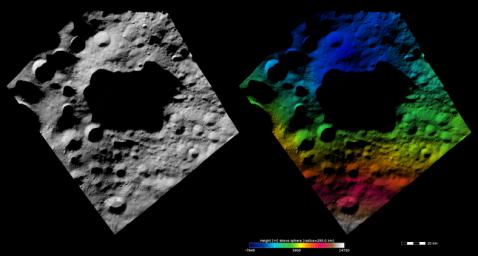These Dawn FC (framing camera) images are dominated by the 45km diameter Domitia crater, after which Domitia quadrangle is named. The left image is an albedo image, which is taken directly through the clear filter of the FC. Such an image shows the albedo (eg. brightness/ darkness) of the surface. The right image uses the same albedo image as its base but then a color-coded height representation of the topography is overlain onto it. The topography is calculated from a set of images that were observed from different viewing directions, allowing stereo reconstruction. The various colors correspond to the height of the area. The white and red areas at the bottom of the image are the highest areas and the blue area at the top of the image is the lowest area. Domitia crater is seen to be a deep crater in the color-coded height image and the many smaller impact craters along its rim are clear in the albedo image.
These images are centered in Vesta's Domitia quadrangle and the center latitude and longitude of the image is 37.0°N, 187.6°E. NASA's Dawn spacecraft obtained this image with its framing camera on October 12th 2011. This image was taken through the camera's clear filter. The distance to the surface of Vesta is 700 km and the image has a resolution of about 70 meters per pixel. This image was acquired during the HAMO (High Altitude Mapping Orbit) phase of the mission. The images are lambert-azimuthal map projected.
The Dawn mission to Vesta and Ceres is managed by NASA's Jet Propulsion Laboratory, a division of the California Institute of Technology in Pasadena, for NASA's Science Mission Directorate, Washington D.C. UCLA is responsible for overall Dawn mission science. The Dawn framing cameras have been developed and built under the leadership of the Max Planck Institute for Solar System Research, Katlenburg-Lindau, Germany, with significant contributions by DLR German Aerospace Center, Institute of Planetary Research, Berlin, and in coordination with the Institute of Computer and Communication Network Engineering, Braunschweig. The Framing Camera project is funded by the Max Planck Society, DLR, and NASA/JPL.
More information about Dawn is online at http://dawn.jpl.nasa.gov.

 Planetary Data System
Planetary Data System












